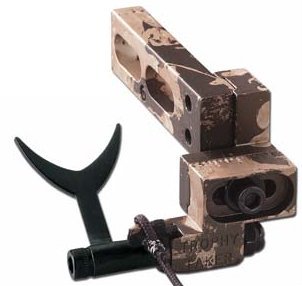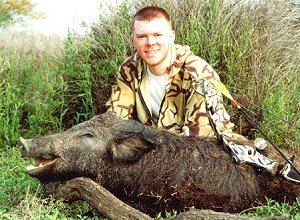
Trophy Taker Arrow Rest

- Manufacturer: Trophy Taker
- Web site: www.trophytaker.com
- Review date: June 15, 2002
- Reviewer: Joshua Flournoy
- H.I.S. Rating: 9 out of 10
Specs:
- "Fall-Away" style arrow rest
- Aluminum & Stainless Steel construction
- Windage & Elevation micro-adjustments
- 1 1/8" wide stainless Arrow Launcher

A Texas wild hog I took while using the Trophy Taker arrow rest
Review:
The Trophy Taker is a "Fall-Away" style arrow rest, one of a number of "Fall-Away" rests available on the market. The Trophy Taker was one of the first on the market, though, and is by far one of the most popular arrow rests around today.
The advantages of the "Fall-Away" style rest are several. It eliminates fletching contact with the rest and therefore improves arrow flight, sometimes dramatically, usually increasing accuracy as well. It also frequently allows you to shoot a wider variety of broadhead weights and designs well, assuming your bow is tuned properly.
When I got my Trophy Taker rest last year they were making two different models - the Original, and the Shakey-Hunter. The only real difference between them was the dimensions of the part of the rest that actually "cradles" the arrow shaft. They call it the "launcher". The "launcher" cradle I got was the Shakey-Hunter, which is a good deal wider and deeper than the original, hence the moniker "Shakey-Hunter".
This rest has a strong nylon cord (similiar to a release loop cord) that attaches to the bow's cables to control the arrow launcher. At full draw, the cables and cord slide back, raising the launcher. When you release, the cables jump forward, instantly dropping the launcher out of the way and providing complete clearance for vanes. Because the cord attaches to the cables themselves instead of the cable guard, the Trophy Taker will work on any bow regardless of whether it has an upper or lower cable guard. Some of the other "Fall-Away" style rests will work on both types as well, but some of them require modifying to do so. The Trophy Taker doesn't have to be modified.
I tested out several "Fall-Away" style arrow rests this past hunting season, including the Trophy Taker's biggest competitor, and after all the testing was done, the Trophy Taker came out on top as my personal favorite, overall. There were several reasons for this.
The simplicity of the design and working parts of the Trophy Taker is really nice. The design of the rest is extremely simple and very sturdy. The launcher is the only part of the rest that moves during operation, making for less noise and less things to worry about breaking. There are no moving arms, stoppers, or sliding cable guards to worry about breaking or making noise. When hunting whitetails, the smallest little noise from your arrow rest can sometimes mean the difference in getting a shot and watching a white flag run away while you're at full draw. After testing out the rest and analyzing it a lot, I don't really think there is anything on it that could break. It's almost all made of heavy-duty aluminum, which also makes it very, very light - it was the lightest of any "Fall-Away" rest I tested. There are no plastic parts on this rest.
The only noise the Trophy Taker makes is when the launcher hits the arrow shelf to stop. This can be eliminated, though, with some adhesive-backed fleece. I put some on my bow shelf and also on the underside of the launcher arm of the rest. I also cut a piece of fleece to put on the top side of the launcher arms to keep the arrow quiet as it moves across during the draw. This took only a few minutes.
The only area that the Trophy Taker didn't come out on top in, in my opinion, was set-up. The instructional video isn't very helpful if you're a visual learner who needs to actually see the rest being set-up to learn how to do it. The reason I say this is because the camera angles and the close-ups weren't all that great. It took a bit to figure out whether to use the Bungee cord of the Nylon cord, and then it took a bit to figure out exactly the best way to adjust the rest to my bow, how long the cord needed to be, etc. I did finally figure it out, but instead of "tying off" the "tab"(rest) end of the Nylon cord, I used string nocks to make the adjustments and hold the cord in place at the rest end of the cord. I found it to be quicker to set-up that way, easier to make adjustments, and just as strong. While I did have a few difficulties in setting the rest up initially, there were others I tested that were much more difficult to set-up.
One thing about the Trophy Taker that did annoy me a bit - and this problem was not unique to the Trophy Taker - is that I had to jerry-rig an "arrow-holder" to keep the arrow resting in one place on the bow shelf when the launcher arm was in the "down" position. I was thinking it would be a good idea if Trophy Taker sold something for that purpose. Well, I looked at their web site just yesterday, and what do you know, they now have an "arrow holder guide" accessory available. I'll be getting one of those as soon as I can and it looks like it will solve the problem completely.
After I got the rest set-up properly, it didn't take any time to see improved arrow flight and accuracy, just like I was hoping to see. I also noticed that there was a drastic difference in the number of different broadhead styles and weights that would shoot well on the same arrow using the Trophy Taker rest. Most of the heads also shot to the same point of aim at 20 yards or less, which was very nice. I don't know if others have experienced that as well, but that's what happened with my bow/arrow/rest set-up.
During the winter my first hunt with the Trophy Taker was in south Texas for hogs and javelina. It performed with no problems at all. I shot a nice hog and a good boar javelina both. The arrows went right where I aimed.
The best recommendation that I can give the Trophy Taker is that I will be using it exclusively on my main hunting bow this fall.
Pros:
Very sturdy, few moving parts, excellent operation, light, great arrow flight, deep & wide arrow cradle
Cons:
A few difficulties in initial set-up
Hunting Information Systems Site Directory
Copyright © 2026 Hunting Information Systems
web application and database development by davidcdalton.com